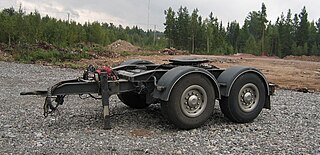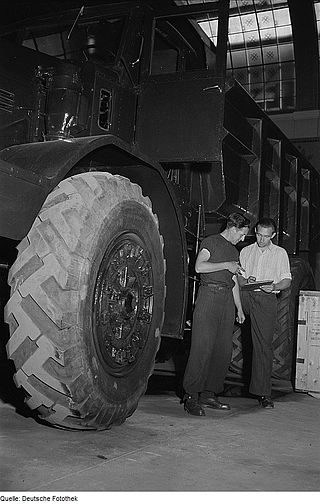
A semi-trailer truck, also known as a semi-truck, (or semi, big rig, tractor-trailer, or eighteen-wheeler) is the combination of a tractor unit and one or more semi-trailers to carry freight. A semi-trailer attaches to the tractor with a type of hitch called a fifth wheel.

A half-track is a civilian or military vehicle with regular wheels at the front for steering and continuous tracks at the back to propel the vehicle and carry most of the load. The purpose of this combination is to produce a vehicle with the cross-country capabilities of a tank and the handling of a wheeled vehicle.

The 101 Forward Control or Land Rover 101FC was a light utility vehicle produced by Land Rover for the British Army. It was not available to the public off the production line, but was as military surplus.
In aviation, pushback is an airport procedure during which an aircraft is pushed backwards away from its parking position, usually at an airport gate by external power. Pushbacks are carried out by special, low-profile vehicles called pushback tractors or tugs.

Minsk Automobile Plant (MAZ) is a state-run automotive manufacturer association in Belarus, one of the largest in Eastern Europe.

An artillery tractor, also referred to as a gun tractor, is a specialized heavy-duty form of tractor unit used to tow artillery pieces of varying weights and calibres. It may be wheeled, tracked, or half-tracked.

A dolly is an unpowered vehicle designed for connection to a tractor unit, truck or prime mover vehicle with strong traction power.

The fifth-wheel coupling provides the link between a semi-trailer and the towing truck, tractor unit, leading trailer or dolly. The coupling consists of a kingpin, a 2-or-3+1⁄2-inch-diameter vertical steel pin protruding from the bottom of the front of the semi-trailer, and a horseshoe-shaped coupling device called a fifth wheel on the rear of the towing vehicle. As the connected truck turns, the downward-facing surface of the semi-trailer rotates against the upward-facing surface of the fixed fifth wheel, which does not rotate. To reduce friction, grease is applied to the surface of the fifth wheel. The configuration is sometimes called a turn-table in Australia and New Zealand, especially if it is a rotating ball-race-bearing type. The advantage of this type of coupling is towing stability.

Ground support equipment (GSE) is the support equipment found at an airport, usually on the apron, the servicing area by the terminal. This equipment is used to service the aircraft between flights. As the name suggests, ground support equipment is there to support the operations of aircraft whilst on the ground. The role of this equipment generally involves ground power operations, aircraft mobility, and cargo/passenger loading operations.
The MAZ-543/MAZ-7310 "Uragan" is a Soviet/Belarusian 8×8 artillery truck designed and developed by MAZ, in what is now Belarus.

A missile vehicle, also known as a missile carrier, missile truck, or missile launcher vehicle, is a military vehicle that is purpose-built and designed to carry missiles, either for safe transportation or for launching missiles in combat. Missile vehicles include transporter erector launchers (TEL) and multiple rocket launchers (MRL).

MAZ-500 is a Soviet truck manufactured at the Minsk Automobile Plant. The first prototype MAZ-500 ran as early as 1955 and they were shown to the public in 1958. Delays in engine development pushed full production back to 1965, although limited production started in 1963. The MAZ-500 is a cab over truck instead of the MAZ-200's conventional layout. This was done to increase payload and reduce weight as well as reduce fuel consumption. The engine itself was quite modern, a direct injection 11,150 cc (680 cu in) diesel V6 built by the Yaroslavl Motor Plant with 180 PS (132 kW) at 2100 rpm. The truck's design was also innovative, with a tilting cabin, which was still rare in the West as well. It also had a number of features designed to make the truck operable under the arduous conditions found in Siberia.
Kurgan Wheel Tractor Plant named after D. Karbyshev was a manufacturer of special heavy automotive machines since 1950 located in Kurgan, Kurgan Oblast.

MAZ-5335 is a Soviet truck, manufactured at the Minsk Automobile Plant from 1977 to 1990.

MAZ-525 was a Soviet heavy truck produced by the Minsk Automobile Plant. Development started in 1949 at the Yaroslavl Automobile Plant Design Bureau as the YaAZ-225. It was planned to install a cab from the YaAZ-200, offset to the left. However, further technical documentation was passed on to MAZ where the design was substantially enhanced.

The MAZ-530 is a Soviet-era heavy-duty dump truck with 6×4 wheels, produced at the Minsk Automobile Plant and Belarusian Automobile Works from 1957 to 1960 and from 1960 to 1963, respectively.

The Autocar Model U8144T, officially "5- to 6-Ton, 4×4, Ponton Tractor Truck", was the largest, and most heavy-duty, of a family of heavy four-wheel drive trucks developed for, and deployed primarily with, the United States Army in World War II. They were of a "cab over engine" design, and produced by the Autocar Company from 1941 to 1945 with 2,711 being built.

Belarus had third by volume part of automotive industry of the Soviet Union with near 40,000 annual production. Since that times Belarus specializes on production of own designed superheavy, heavy and middle trucks mainly plus post-Soviet developed buses, trolleybuses and trams. Auto manufacturers in Belarus include MAZ, BelAZ and Neman.

The MAZ-538 is a heavy, wheeled bulldozer which was designed and built in the Minskyi Avtomobilnyi Zavod from the 1950s for the Soviet armed forces. It was preceded by the prototype MAZ-528. Over the decades, various modifications have been made, some of which are still used today. Production was discontinued in the early 1990s.

The MAZ-529 (МАЗ-529) is a uniaxial tractor designed by the Soviet vehicle manufacturer Minsky Automobilny Zavod (MAZ), which started production in 1959. From 1958, production of this type was relocated to MoAZ as part of the specialization of the Soviet automobile industry and continued there until 1973 under the name MoAZ-529.

















